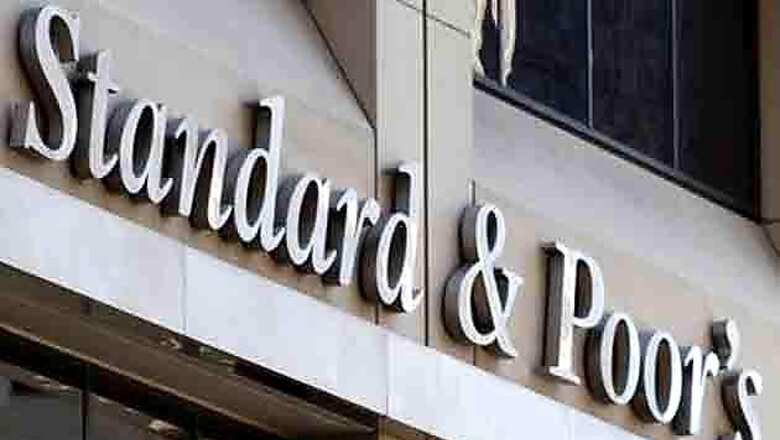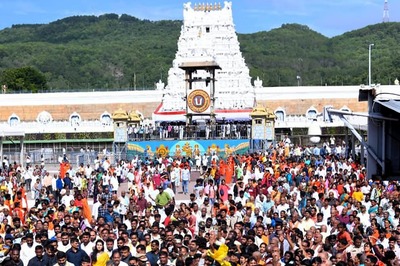
views
Mumbai: Standard and Poor's (S&P) lowered India's rating outlook to negative and warned of a downgrade in two years if there is no improvement in the fiscal situation and the political climate continues to worsen.
Indranil Sengupta, chief economist India of BoAML doesn't think there is a case for downgrading India.
According to him, rating agencies ultimately are a mirror of the reality. "So, to that extent, the S&P is only mirroring the fact that things have not gone well in India. It is another matter that things have not gone well in many countries, but that doesn't mean that they are not going badly in India," he elaborates.
He further says, the organisation's numbers are probably more bearish than S&P's in a number of categories.
Below is the edited transcript of his interview with CNBC-TV18's Udayan Mukherjee and Mitali Mukherjee.
Q: What did you make of the S&P's observations? Does that change your own risk parameters any?
A: Our numbers are probably more bearish than S&P's in a number of categories. I think rating agencies ultimately are a mirror of the reality. So, to that extent, the S&P is only mirroring the fact that things have not gone well in India. It is another matter that things have not gone well in many countries, but that doesn't mean that they are not going badly in India.
Q: How much of a chance do you see of an actual downgrade 9, 12, 15 months down the line? Do you think it will come to that?
A: That I doubt. It's not easy to downgrade a country which has second highest growth in the world. I also think that we still have USD 300 billion of FX reserves. The fiscal deficit is probably going to be higher than the 8 per cent the S&P is talking about, probably around 8.5 per cent, center plus state. But the debt-to-GDP ratio is coming off. So, on balance, I think there is a need for the government to step up reforms. Maybe NRI deposit scheme is crying for action at the RBI's end. But I don't think there is a case for downgrading India.
Q: What specifically would the S&P like to see in your eyes for them to not press the downgrade trigger over the next six to nine months?
A: I think there are two things. One is that the fiscal numbers don't get worse. Everyone knows that there is going to be the fiscal slippage. But maybe if the centre's fiscal deficit doesn't exceed 6 per cent or something versus the target of 5.1 per cent. So, I think that's one. Secondly, I think they would like to see some attrition to FX reserves. That is why I think either a NRI deposit scheme or some kind of a liberalisation of FII debt flows with some kind of a tenure cap could be welcome. Finally, I think some movement on reforms atleast an oil price hike as soon as possible.
Q: What do you think the Reserve Bank will be thinking or looking at in this context? As you said any decision that the S&P takes is basically an acceleration of the problems that already exist. Does this at all change the turf for them in terms of decision making?
A: I think there are two things from the RBI's side. One is clearly there has to be some conscious move to shore up FX reserves. We didn't buy FX reserves for three years. We sold USD 50 billion. All external debt ratios look weaker than before. So, I think that's something that the RBI will need to do.
Secondly, I think somewhere down the line there has to be some more rate cuts to support growth. Ofcourse inflation will go up in the middle of the year, so RBI will probably have to pause. But maybe again towards the end of the year you should have more rate cuts to support growth.
Q: Do you think it will also push the Reserve Bank into a corner in terms of defending the rupee more aggressively than it may have done in the past couple of weeks?
A: I think the best defense of the rupee is to shore up FX reserves. Selling FX reserves will only deplete whatever arsenal you have. Right now, I think the big question is how does the RBI get more FX reserves in rather than how much FX reserves the RBI sells to support the rupee. So, my sense is that at some stage I would look for some measures to boost FX reserves, be it NRI deposit scheme like I said or some liberalisation of FII debt flows, but with a tenure cap. There should be some measure to boost FX reserves.
Q: Do you think it's politically difficult for the government to do much of what you are suggesting, particularly on the issues like passing down fuel prices to lower the fiscal deficit somewhat? If it does not manage to do any of that because of political compulsions then could the rating agency start to become more hawkish?
A: I think the government has to raise fuel prices. If oil is at USD 120 per barrel, you have to raise fuel prices by atleast 10 per cent. If you raise fuel prices, cooking gas, LPG, kerosene, diesel by 10 per cent, you will get a fiscal deficit of 5.9 per cent versus your 5.1 per cent target. So, you just have to raise fuel prices. The sooner the better because the more you loose in terms of time the more of a fiscal cost you incur.


















Comments
0 comment